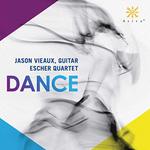|
Back
08/01/2019
“Dance”
Mario Castelnuovo-Tedesco: Guitar Quintet, opus 143
Aaron Jay Kernis: 100 Greatest Dance Hits
Luigi Boccherini: Guitar Quintet N° 4 in D major “Fandango”
Jason Vieaux (guitar), Escher Quartet: Adam Barnett-Hart (violin), Aaron Boyd (violin), Pierre Lapointe (viola), Brook Speltz (cello)
Recording: Sauder Hall, Goshen College, Goshen, Indiana (September 24-25, 2015) – 57’18
Azica Records 71328 – Booklet in English

   
Guitarist Jason Vieaux and the Escher Quartet’s release “Dance” features chamber guitar music that is rarely performed live on the concert hall stage, so this Azica recording is without doubt the next best experience. Vieaux takes this program on the road. In many ways, it is the perfect follow-up to Vieaux’s Grammy © award-winning (and excellent) 2015 solo album, “Play”, and, in fact, this collaboration with Escher was recorded that same year.
With Vieaux and the Escher Quartet – violinists Adam Barnett-Hart and Aaron Boyd, violist Pierre Lapointe and cellist Brook Speltz – the ensemble virtuosity is expected, but there is also that undefinable collaborative mystique that comes through in these “Dance” studio sessions.
The Escher Quartet chose their name in homage to Dutch artist M.C. Escher inspired by the artist’s use of ‘interplay’ in his surrealist artworks. Not coincidently, the ‘interplay’ of the string dialogues between protagonist guitar and violins, cello and viola is, indeed, the crucial artistic component of chamber playing. “Dance” is most alive as Vieaux and Escher illuminate the specific form of classical dance music by composers Mario Castelnuovo-Tedesco, Aaron Jay Kernis, and Luigi Boccherini.
Andrés Segovia first performed Castelnuovo-Tedesco’s Guitar Quintet after being asked by Los Angeles Music Guild director Alfred Leonard to participate in a chamber music concert. Segovia had reservations because of the limited repertoire for guitar, but he agreed if Castelnuovo-Tedesco wrote something new. The composer later wrote that he “took the challenge.”
The work is distinguished for its sumptuous folkloric-modernist structure and journeying expressiveness. The opening “Scherzo” is a jaunty pastoral lark. The “Allegro” accelerates to a pasodouble, then slowly fades to gypsy ballade voicings. The work has lost none of its luster 70 years after Segovia premiered it, and this recording should bring new attention to a hidden contemporary classic.
Aaron Jay Kernis’ 100 Greatest Dance Hits, composed in 1993, was inspired by ‘greatest hits’ tv collections of popular music, as seen on late night television. A wry jumping-off point, the four-movement piece has echoes of guitar classicism, but it is altogether a sumptuously progressive and dramatic concerto for strings. Vieaux states it is the themes with a percussive solo guitar (“Introduction to the Dance Party”) that summon pulsing pizzicati from the violins. The rhythmic progressions give way to lyrical arpeggio guitar riffs and whirlwinds of string counterpoints (“Salsa Pasada”) that gears down to what Ellington called ‘decrescendos in blue.’
The longest movement is called “MOR Easy Listening Slow Dance Ballad”, and it is definitely not middle-of-the road music. The cello strums ignite swirling string passages, with flamenco fire by Vieaux in chromatic orbit. It hints of dramatic narrative, and it registers like film atmospherics of a lost lover. Then onto “Dance Party on the Disco Motorboat” that speeds off into a sound matrix of strings on different trajectories, grounded eventually by Vieaux’s lusty guitar lead while the musician shouts “Dance Party!”
Luigi Boccherini was an Italian cellist, but he lived most of his life in Spain. He was a prolific composer pumping out hundreds of compositions at the behest of his long-distance patron, King Wilhelm II of Prussia. He composed dozens of symphonies, but primarily chamber works and over 120 string quintets. Mysteriously most of them are lost. Laurie Shulman’s excellent CD notes explain the lineage of Boccherini’s music, and even though it is known that he was prolific in composing numerous chamber pieces, the guitar quintets have gone missing. The Guitar Quintet N° 4 in D major is a transcription of six quintets for piano and strings. The opening “Pastorale” casts its enchanting time-traveling spell with a 17th century “Allegro maestoso” court dance gliding from a minuet to a spirited sarabande. The elegance of the interlude, “Grave Assai”, gives way to virtuosi Spanish guitar classicism, and it is laced through the “Fandango” with the thrilling Vieaux/Escher finale performing a blazing dance of the strings.
The specificity of this rarer repertory is a feast for the senses as performed. Dance has the energy of a live performance session rather than a studio set. Superb mastering by engineer Bruce Egre captures precision acoustical dimensions of the strings achieved in Sauder Hall at Goshen College.
Lewis J. Whittington
|